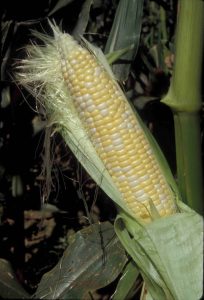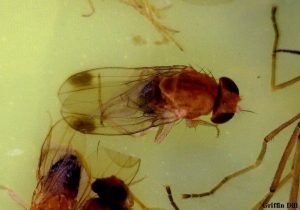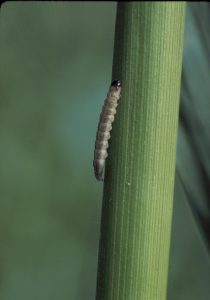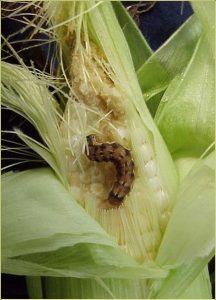Sweet Corn IPM Newsletter No. 6 – August 3, 2018
 Sweet Corn IPM Newsletter No. 6 – August 3, 2018
Sweet Corn IPM Newsletter No. 6 – August 3, 2018
Click on photos to enlarge.
CORN EARWORM THREATENS ALL SILKING CORN
Most Sites Now Have Significant Moth Populations in Silking Corn
SITUATION
As predicted, the warm weather from the south has brought an increase in insect activity, as we come into the peak of the sweet corn season. Growers should be monitoring their fields regularly and be prepared to protect silking corn from the threat of earworm and corn borer. Fall armyworm is likely to become more of a threat in the coming days.
European corn borer: Activity in pheromone traps increased in most fields this week, although it has not yet led to a noticeable increase in feeding damage. This will likely follow soon however, as the eggs these moths are laying begin to hatch. When more than 5 moths are caught in a trap in a week, a spray is recommended for all silking corn to prevent larvae from entering the ears directly after hatching. Moths exceeded this threshold in Bowdoinham, Garland, Lewiston, New Gloucester, Oxford and Wells. However, all of these sites, except the one Wells field, were also under a spray interval for corn earworm, which should also protect against corn borer. Feeding damage in the field was very light, with no sites over the 15% spray threshold for pre-tassel to silking corn; but this is likely to increase soon.
- European Corn Borer Larva; photo by David Handley
- Corn Earworm Feeding on Corn; photo by David Handley
Corn earworm: Numbers of moths caught in traps increased significantly at nearly all sites monitored this week, leading to sprays recommended for corn in most silking fields. A 6-day spray interval for all silking corn was recommended for our sites in Bowdoinham, one Lewiston site, North Berwick, and Oxford. A 5-day spray interval was recommended for one Cape Elizabeth site, Dayton, Garland, one Lewiston site, Nobleboro, Poland, Sabattus and Wayne. A 4-day spray interval was recommended for silking fields in Biddeford, one Cape Elizabeth site, one Dayton site, Levant, New Gloucester, and one Wells site. At this point, it is likely corn earworm pressure will continue and growers should be prepared to protect all silking corn.
Fall armyworm: No moths were caught in our pheromone traps this week, but we anticipate we will be seeing them soon because we are finding some larval feeding. None of the injury was over the 15% spray threshold.
Squash vine borer: Moths were over the 5 moth per week threshold in Oxford. All other sites had either one or no moths this week.
Spotted wing drosophila: Fly counts have been variable this week, with some locations seeing increases (Limington, Readfield) while most locations still had very few, if any flies. The recent heat and rain will improve conditions for spotted wing drosophila (SWD), because they likely increased the amount of rotten fruit in the field and the level of moisture. Both are conducive to fly presence and reproduction. Try keep the planting as free from rotten fruit as possible, remove excess vegetative growth, especially near the base of the plants, and apply a suitable insecticide when flies are observed or larvae are found in the fruit. For more information visit our SWD blog.

Sincerely,
David T. Handley
Vegetable and Small Fruit Specialist
Highmoor Farm, P.O. Box 179, 52 US Route 202, Monmouth, ME 04259, 207.933.2100
UMaine Extension Diagnostic Research Lab, Pest Management Unit, 17 Godfrey Drive, Orono, ME 04473, 1.800.287.0279
| Location | CEW Moths |
ECB Moths |
FAW Moths |
%Feeding Damage |
Recommendations / Comments |
|---|---|---|---|---|---|
| Biddeford | 8 | 1 | 0 | 0% | 4-day spray interval recommended on all silking corn |
| Bowdoinham | 2 | 16 | 0 | 0% | 6-day spray interval recommended on all silking corn |
| Cape Elizabeth I | 4 | 0 | 0 | 0% | 5-day spray interval recommended on all silking corn |
| Cape Elizabeth II | 24 | 1 | 0 | 4% | 4-day spray interval recommended on all silking corn |
| Charleston | 0 | 2 | 0 | 0% | No spray recommended |
| Dayton I | 4 | 0 | 0 | 0% | 5-day spray interval recommended on all silking corn |
| Dayton II | 8 | 3 | 0 | 2% | 4-day spray interval recommended on all silking corn |
| Farmington | 0 | 2 | 0 | 0% | No spray recommended |
| Garland | 4 | 5 | 0 | 5-day spray interval recommended on all silking corn | |
| Levant | 33 | 0 | 0 | 1% | 4-day spray interval recommended on all silking corn |
| Lewiston I | 2 | 5 | 0 | 0% | 6-day spray interval recommended on all silking corn |
| Lewiston II | 5 | 3 | 0 | 0% | 5-day spray interval recommended on all silking corn |
| New Gloucester | 12 | 5 | 0 | 0% | 4-day spray interval recommended on all silking corn |
| Nobleboro | 6 | 3 | 5-day spray interval recommended on all silking corn | ||
| No. Berwick | 3 | 2 | 0 | 1% | 6-day spray interval recommended on all silking corn |
| Oxford | 2 | 15 | 0 | 0% | 6-day spray interval recommended on all silking corn |
| Palmyra | 0 | 3 | 0 | 0% | No spray recommended |
| Poland | 5 | 0 | 0 | 5-day spray interval recommended on all silking corn | |
| Sabattus | 6 | 2 | 0 | 5-day spray interval recommended on all silking corn | |
| Wales | 1 | 1 | 0 | 0% | No spray recommended |
| Wayne | 4 | 0 | 0 | 0% | 5-day spray interval recommended on all silking corn |
| Wells I | 0 | 28 | 0 | 1% | One spray for ECB on all silking corn |
| Wells II | 14 | 2 | 0 | 0% | 4-day spray interval recommended on all silking corn |
CEW: Corn earworm (Only fresh silking corn should be sprayed for this insect.)
ECB: European corn borer
FAW: Fall armyworm
| Moths caught per week | Moths caught per night | Spray interval |
|---|---|---|
| 0.0 to 1.4 | 0.0 to 0.2 | No spray |
| 1.5 to 3.5 | 0.3 to 0.5 | Spray every 6 days |
| 3.6 to 7.0 | 0.6 to 1.0 | Spray every 5 days |
| 7.1 to 91 | 1.1 to 13.0 | Spray every 4 days |
| More than 91 | More than 13 | Spray every 3 days |
Thresholds apply only to corn with exposed fresh silk. Lengthen spray intervals by one day if maximum daily temperature is less than 80°F.
European Corn Borer Thresholds
Whorl stage: 30% or more of plants scouted show injury.
Pre-tassel-silk: 15% or more of plants scouted show injury.
Silk: 5 or more moths caught in pheromone traps in one week.
IPM Web Pages:
UMaine Cooperative Extension Integrated Pest Management
UMass Amherst Integrated Pest Management
Where brand names or company names are used, it is for the reader’s information. No endorsement is implied nor is any discrimination intended against other products with similar ingredients. Always consult product labels for rates, application instructions and safety precautions. Users of these products assume all associated risks.
The University of Maine is an equal opportunity/affirmative action institution.


